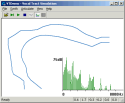Videos in Speech, Hearing and Phonetic Sciences
The Fry-Denes speech recogniser at UCL
A short film describing perhaps the first electronic speech recognition system. It was developed by Denis Fry and Peter Denes at University College London in th 1950s.
Phonetic laboratory instruments of the 1920s
A clip showing instruments from a phonetics laboratory in the 1920s, from 35mm nitrate footage in the UCL Phonetics Film Collection. A kymograph is shown being used to analyse an utterance of the word "potato". The speaker using the kymograph mask is probably Stephen Jones (1872 - 1942), superintendent of the UCL Phonetics Laboratory from its foundation until 1937. A second short sequence shows a sensitive flame (a gas flame adjusted to so as to respond selectively to sound). The speaker (so far unidentified) appears to be articulating various sibilant fricatives; the flame dips on some, but not others. Vocal-tract diagrams are visible on the wall behind the speaker, showing that the location is a phonetics classroom or laboratory.


